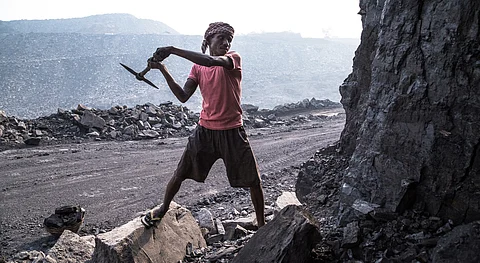

Indian banks have invested nearly $29 billion into the coal sector since 2016. The State Bank of India (SBI) leads the pack among public banks, alongside private lenders like Axis Bank and ICICI Bank, according to a new report titled Coal Ties Hinder Indian Banks’ Energy Transition by Climate Risk Horizons, a think tank based in Bengaluru.
India alone contributed roughly 2.3 per cent of total global coal financing between 2021 and 2023, making it one of the top seven countries contributing to coal financing.
Banks primarily finance coal through loans and underwriting services. While loans involve direct lending, underwriting allows banks to raise funds for coal companies by structuring and facilitating debt or equity issuances. Although banks may assume short-term risk during underwriting, this process significantly funnels capital to coal companies.
Between January 2016 and December 2023, Indian banks loaned roughly $15.22 billion for coal, with public banks accounting for 68 per cent and private banks 32 per cent. They also provided $ 13.56 billion, with a notable shift: 80 per cent came from private banks and 20 per cent from public banks.
While coal loans fluctuated significantly over the eight-year period, coal underwriting by Indian banks stayed relatively stable. The report suggests that private Indian banks’ higher indirect coal financing indicates their continued desire for profit with lower risk exposure.
This follows global trends, where the dominant channel for financing coal globally is underwriting services, with 484 commercial banks providing $1.2 trillion in coal-related funding through this channel alone between 2019 and 2021, the report highlighted.
“Underwriting coal might look cleaner than direct lending, but this backdoor support delays India’s clean energy transition and makes the path to Net Zero more difficult. Banks are starting to acknowledge the financial harm climate change is causing to their portfolio, while simultaneously supporting the climate-destroying coal industry despite proven, financially viable clean energy alternatives,” Anusha Das, co-author of the report, said in a statement.
Globally, over 200 global financial Institutions —including more than 80 banks—have taken steps to transition away from coal by adopting exclusion policies to align with decarbonisation and Net Zero goals. In India though, only three banks — Federal Bank, RBL Bank, and Suryoday Small Finance Bank — have done so.
The report also reiterates that coal is not cost-effective. While electricity tariffs for coal plants under construction range from Rs 6.19 per kilowatt hour (kWh) to Rs 7.24/kWh, round-the-clock (RTC) power from renewables with storage is now available at Rs 3.5 to Rs 4.5/kWh.
Further, repurposing existing land and grid infrastructure at old coal plants for renewables could cut costs by approximately 32 per cent for standalone solar photovoltaic (PV) and solar PV with battery storage, reducing the levelised cost of energy (LCOE) to Rs 1.87/kWh and Rs 2.69/kWh. LOCE measures the average cost of electricity generation over the lifetime of an energy asset.
As of January 2025, 28 GW of coal power capacity were under construction and another 27 GW has been announced. Such plants can be financially viable only if power distribution companies or Discoms sign long-term power purchase agreements (PPA) with the energy producer (seller) that cover costs and guarantee a return regardless of the actual power offtake. Surplus PPAs with high fixed costs could partly explain why state Discoms like those in Tamil Nadu and Maharashtra are performing poorly.
It is expected that India’s capacity utilisation could drop by 47 per cent by 2030 and below 10 per cent by 2035, leaving a significant number of assets worth Rs 8.1 lakh crore stranded by 2046, impacting lenders and investors, the report warned.
“Major Indian banks that have failed to act on the coal front must adopt a transition plan to phase out coal investments and redirect finance to renewable energy,” read the report.
Instead, banks could finance solar and wind power component manufacturing, battery manufacturing, deployment of grid scale storage projects and residential or commercial systems, to accelerate the deployment of renewables at the required pace, the report added.